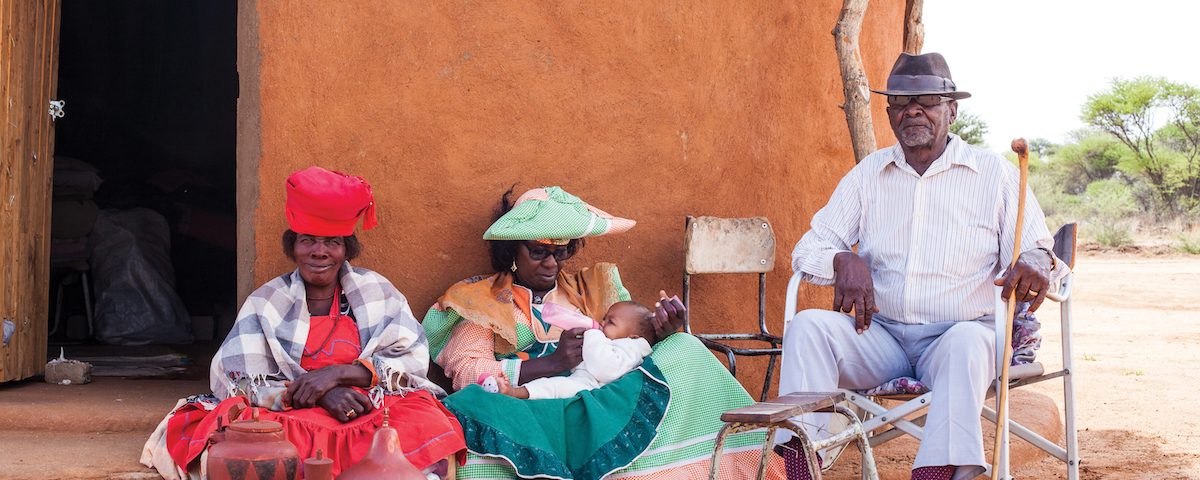
The mountains are calling and I must go
August 28, 2019
The Face of Rhino Conservation
August 28, 2019[vc_row][vc_column][vc_column_text]
A people without the knowledge of their history, origin and culture, is like a tree without roots.
– Marcus Garvey
Text and Photographs Le Roux van Schalkwyk
[/vc_column_text][vc_single_image image=”59643″ img_size=”full” alignment=”center”][vc_column_text]
Walking from one exhibit to the next and viewing artefacts through glass panes, museums can leave the visitor detached from the subject in question. Living museums, on the other hand, give an experiential interpretation of history, bringing it to life by imitating the conditions of a natural environment, historical period or culture. Ombu Cultural Village showcases the history of the Ovaherero people by providing a window into their past while connecting visitors to their present.
The authenticity of the Ombu Cultural Village sets it apart from other run-of-the-mill living museums. It serves as a medium to transport visitors more than a hundred years back into the past. At the same time, the village is the permanent residence of a modern-day Herero family, providing a unique and intimate perspective of the Ovaherero culture, family life and daily routines.
A tour of the Village takes you on a journey through 200 years of history and development. The buildings showcase a change in the design, building methods and style of housing over time. The nine period-specific dwellings built in the traditional semi-circle, progressing from clay and wood to modern houses of brick and mortar, hold a wealth of history which in turn is explained by one of the friendly guides.
On entering the houses, visitors learn how Ovaherero people have lived, collecting and preparing food, making perfumes and clothing, during different periods over the last two centuries. Visitors are encouraged to enhance the experience through touch, smell and taste during the tour.
Villagers can be seen tending livestock, milking cows, churning omaere (milk) and performing day-to-day tasks. Visitors are welcome to interact with them and ask questions to understand the intricate Ovaherero culture better. In this way, Ombu Cultural Village not only documents and preserves the heritage and culture of the Ovaherero people, but allows visitors to reflect on the past while being informed about the present.
Ovaherero folklore, dance, dress and traditional practice reveal a culture centred around cattle. The different facets of the belief system, customs, initiation ceremonies, marriage and economic system are also described.
[/vc_column_text][/vc_column][/vc_row][vc_row][vc_column width=”1/2″][vc_single_image image=”59642″ img_size=”full”][/vc_column][vc_column width=”1/2″][vc_single_image image=”59640″ img_size=”full”][/vc_column][/vc_row][vc_row][vc_column width=”1/4″][vc_single_image image=”59641″ img_size=”full”][/vc_column][vc_column width=”1/4″][vc_single_image image=”59639″ img_size=”full”][/vc_column][vc_column width=”2/4″][vc_column_text]
The last stop of the tour is the thoughtfully designed museum, built in a semi-circle to imitate the shape of a traditional village. The museum contains a rich collection of weapons, tools and artefacts used in hunts, food preparation and other daily tasks from the 19th century to the present. Physical displays, artwork and audio-visual presentations provide accounts of Ovaherero history, migration, wars and how political and economic changes have influenced the social and cultural spheres of the community.
The Ombu Cultural Village was not only created to give visitors a better understanding of the Ovaherero people but also to preserve the heritage, culture, and traditional knowledge for future generations.Ombu Cultural Village is located on the D1525, 48 km from Otjiwarongo and 122 km from Okahandja.
[/vc_column_text][vc_column_text]This article was first published in the Spring 2019 issue of Travel News Namibia.[/vc_column_text][/vc_column][/vc_row]


